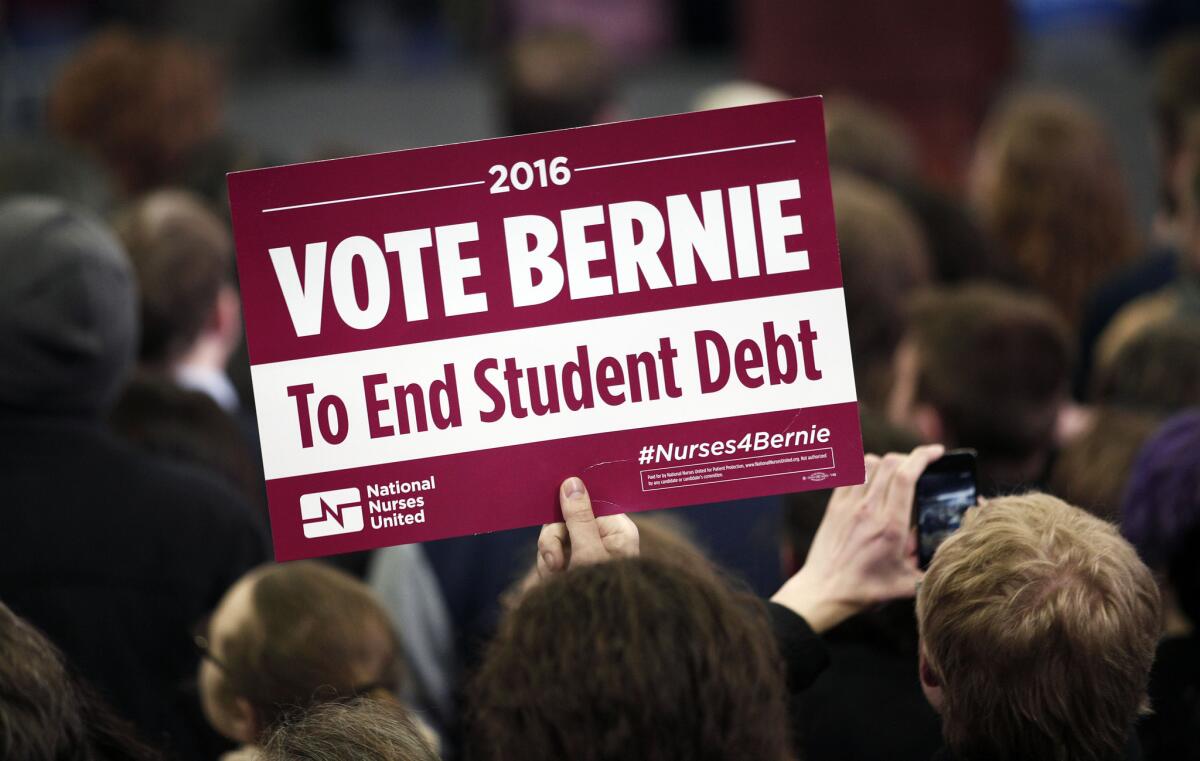Op-Ed: Why does Bernie Sanders want to increase income inequality?

A supporter of Democratic presidential candidate Bernie Sanders holds a sign at Sanders’ first campaign rally in Michigan.
- Share via
Free tuition at public colleges and universities — it’s a rallying cry in Bernie Sanders’ presidential campaign, and it sounds like an effective strategy for ensuring that the widest range of students can graduate from college without burdensome debt. But zero tuition actually runs counter to Sanders’ core principle of reducing income inequality. In this case, what sounds good is not.
Sanders is correct in emphasizing the importance of higher education in reducing income inequality. The evidence is overwhelming that the single most effective mechanism for narrowing the gap between the wealthy and the poor in the United States is a college education. Indeed, studies by many different investigators, such as Henry Brady of Berkeley and Michael Hout of New York University, have shown that over a lifetime, people with a four-year college education will earn at least a million dollars more over their lifetimes than those with only a high school diploma. Thus, we need strategies that will enable public universities to provide excellent educations for students, without saddling those students with crippling debt.
Zero tuition actually runs counter to Bernie Sanders’ core principle of reducing income inequality.
The way that we accomplish this now is principally through “return to aid.” It is, simply put, a mechanism for redistributing wealth within universities. At the overwhelming majority of public universities, a significant portion (typically one third) of the tuition paid by well-to-do students is returned to low income students in the form of financial aid.
In the University of California system, those who can afford tuition will spend about $14,000 a year for in-state tuition and fees, and $38,000 for out-of-state tuition and fees. Low income California residents already pay no tuition at all; it is covered by state-funded Cal Grants. The return to aid program, along with federal Pell grants, then helps low-income students with educational expenses other than tuition: food, shelter, books and computers, which typically make up over half of the total cost of attending college. At Berkeley and Davis, return to aid from international students provides significant financial aid for middle class Californians too.
In other states, return to aid helps students with both living needs and tuition expenses, usually in combination with state and federal grants. Whatever the mix, return to aid is an essential element of support for students who otherwise could not possibly attend college.
A significant portion ... of the tuition paid by well-to-do students is returned to low income students in the form of financial aid.
Sanders’ plan, in contrast, would increase taxes on the wealthy and on corporations to pay the basic cost of educating all students, rich and poor. Superficially, it’s an appealing idea, but it would be counterproductive to increase taxes to enable students from well-off families to attend college for free. Zeroing out tuition nationally would require tripling public funding for most state colleges and universities. It is entirely unrealistic to believe that taxes would be increased enough to provide that funding. The share for return to aid would certainly drop and probably disappear, defunding low income students.
The past decade has seen unprecedented disinvestments by states in higher education. Shockingly, at least 12 states, including California, now spend more money putting people in prison than they do educating them. In spite of a much improved economy, public funding of the University of California is still meager. For example, in 2004, the state provided 29% of Berkeley’s budget; now it is about 12% and shows no sign of improving. If a newly elected President Sanders were able to increase tax revenue what reason is there to believe that it would go to higher education?
Much attention is paid to the student debt crisis, but because of return to aid and Cal Grants, students who graduate from the University of California have the lowest debt load of any public research university graduates in the nation — about $18,000 for those students (slightly more than half) who finish school with any debt at all.
It is presumed by zero tuition enthusiasts that free tuition will go hand in hand with lessening income inequality in the United States; in fact, it will mean the exact opposite. Fewer low income students will be able afford the full cost of going to college.
In my view, the financially well off can and should pay for the excellent public education they receive at UC and other public universities around the country. The last thing we want to do is to take away the single most reliable mechanism of income redistribution already in place: return to aid. Said starkly, zero tuition equals zero low income students.
Robert J. Birgeneau was chancellor of UC Berkeley from 2004 to 2013. He now teaches public policy, and physics, materials science and engineering at Berkeley.
Follow the Opinion section on Twitter @latimesopinion and Facebook
ALSO
Here are the new emoticons Facebook really needs
Gun silencers are useful, not scary
Why Texas matters politically more than ever
More to Read
A cure for the common opinion
Get thought-provoking perspectives with our weekly newsletter.
You may occasionally receive promotional content from the Los Angeles Times.










